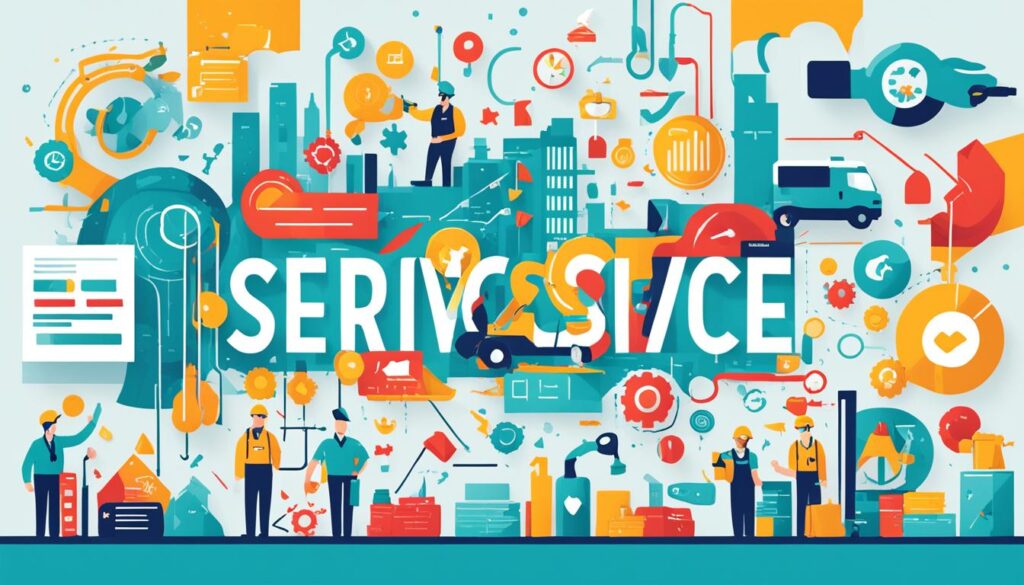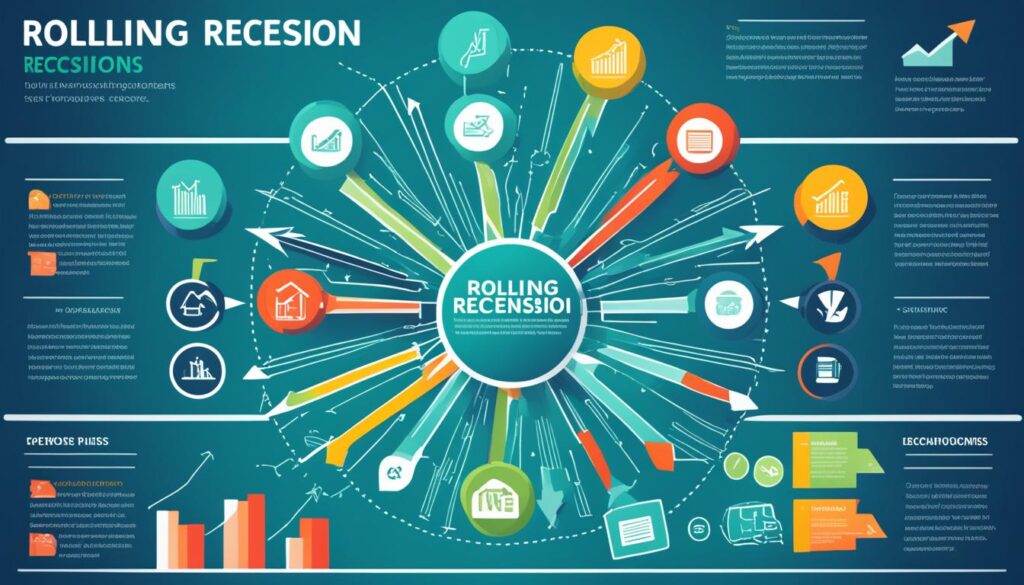“As an Amazon Associate I earn from qualifying purchases.”
As you navigate the ever-shifting tides of the economy, a new phenomenon known as a “rolling recession” has emerged, presenting both challenges and opportunities. This unique economic landscape is characterized by contractions in specific sectors while others remain resilient, leading to an overall sluggish growth and slowing economy without a full-blown economic downturn.
Imagine a storm cloud passing overhead, casting shadows on some areas while leaving others untouched. The rolling recession operates in a similar manner, with business cycle contraction and GDP decline affecting certain industries, while others continue to thrive, offsetting the contractions and mitigating a widespread recessionary pressure.
At the heart of this economic shift lies a complex interplay of consumer spending drop, employment stagnation, and a manufacturing slump in specific sectors. As we delve deeper into this phenomenon, you’ll gain a better understanding of how to navigate these uncharted waters and position yourself for success amidst the ever-changing tides.
Key Takeaways
- A rolling recession involves sectoral shifts, with some industries contracting while others expand.
- It leads to an overall economic slowdown but avoids a full-blown recession.
- Consumer spending patterns, employment trends, and manufacturing output play a crucial role.
- Navigating a rolling recession requires adapting strategies to sector-specific challenges and opportunities.
- Understanding the dynamics of a rolling recession is key to mitigating its impact and capitalizing on potential growth areas.
Understanding the Rolling Recession Concept
A rolling recession is a unique economic phenomenon characterized by specific sectors or industries experiencing recessionary conditions, such as declining production, job losses, and reduced consumer demand, while others remain relatively stable or even expand. This uneven economic performance across various sectors results in an overall economic contraction but not a complete recession.
Definition and Key Characteristics
The National Bureau of Economic Research (NBER) defines recessions as a significant decline in economic activity that lasts more than a few months, typically involving two consecutive quarters of falling real GDP. However, a rolling recession deviates from this traditional definition, as it involves sectoral shifts where some industries face an industry slump while others continue to expand, offsetting the contractions and preventing a full-blown recession.
Sectoral Shifts and Impact on Overall Growth
In a rolling recession, the uneven economic growth across different sectors results in a mixed economic picture. While certain industries experience recessionary pressures, with declining output, job losses, and reduced consumer demand, other sectors may thrive, driven by robust consumer spending, technological advancements, or favorable market conditions. This dynamic interplay of contractions and expansions ultimately leads to an overall slowdown in economic growth but not a widespread, simultaneous downturn.
The current economic situation in the United States is often described as a “rolling recession,” with some industries contracting while others expand. The S&P Global US Sector Purchasing Managers’ Index for February 2023 illustrates this mixed picture, with three out of seven sectors experiencing increased business activity, particularly the technology sector, while others like financials faced challenges.
This uneven growth across sectors presents both challenges and opportunities for businesses, policymakers, and consumers, as they navigate an economic landscape marked by sectoral shifts and varying levels of economic performance.
Exploring the “Rolling Recession” Theory
The concept of a “rolling recession” has gained prominence as the economy navigates an uneven landscape of sectoral contractions and expansions. This phenomenon provides a lens through which we can understand the nuanced dynamics shaping our current economic trajectory.
Housing Industry: The First Domino to Fall
The housing market has emerged as a bellwether for the rolling recession, with rising interest rates and declining demand acting as catalysts for its housing market decline. As mortgage rates nearly doubled, home sales plummeted by a staggering 19% compared to the previous year, signaling the onset of an economic contraction within this crucial sector.

Manufacturing Slump Follows Suit
In the wake of the housing industry’s downturn, the manufacturing sector experienced a ripple effect, facing its own manufacturing slowdown. Factory production declined year-over-year, reflecting the reduced consumer demand and higher borrowing costs that permeated the broader economy. This industry slump further exacerbated concerns about the potential breadth of the rolling recession.
| Sector | Contraction Rate (2023) |
|---|---|
| Construction | 0.9% |
| Production | 1.1% |
| Services | 0.1% |
The table above illustrates the uneven contraction rates experienced across major sectors of the UK economy at the end of 2023, underscoring the unique challenges posed by the rolling recession.
The Tech Industry’s Layoff Wave
As the rolling recession gripped various sectors, the tech industry found itself grappling with a wave of job cuts and layoffs. Major players in the field were forced to streamline their workforce, a move driven by shifting consumer spending patterns and broader economic slowdown pressures.
Tech giants like Meta (Facebook’s parent company), Zoom, and Google faced the harsh realities of the recessionary pressures, reducing their workforce as consumer spending shifted from online activities to physical stores and restaurants in the post-pandemic era. This transition led to a contraction in the tech sector, further contributing to the overall economic slowdown.
- Alphabet laid off hundreds of employees within its recruiting team to streamline operations and increase efficiency.
- SecureWorks announced layoffs affecting 15% of its workforce, around 300 employees, with expenses estimated at $14.2 million.
- Rapid7 laid off 18% of its workforce, approximately 400 global employees, resulting in estimated costs between $24-$32 million.
- Cisco announced layoffs as part of a restructuring plan, eliminating 5% of its 83,000 workforce.
The wave of tech industry layoffs rippled across various sectors, from cloud computing to cybersecurity, as companies grappled with the economic slowdown and realigned their strategies to weather the rolling recession.
| Company | Layoffs | Impact |
|---|---|---|
| Evernote | Most staff in US and Chile | Move to Europe, 16 weeks’ salary, and benefits |
| Oracle | Cuts at Cerner healthcare unit | Project issues for US Dept. of Veterans Affairs |
| Zendesk | 8% workforce reduction | Macroeconomic uncertainties and competition |
| Stack Overflow | 10% workforce, at least 58 employees | – |
As the tech industry grappled with the rolling recession, companies were compelled to make difficult decisions, resulting in a significant wave of job cuts and layoffs that reverberated throughout the sector and contributed to the broader economic slowdown.
Rolling Recession: Potential Advantages
While contractions in sectors like housing, manufacturing, and technology can be challenging, a rolling recession presents unique advantages stemming from the service sector resilience. As consumers shift their spending patterns, the robust performance of service industries can counterbalance the slumps in other areas, mitigating widespread economic downturn and uneven growth.
Offsetting Contractions with Robust Service Sector
During a rolling recession, the resilience of the service sector plays a pivotal role in offsetting contractions in other industries. As consumers ramp up their expenditures on travel, entertainment, and hospitality services, this expansion can effectively counterbalance the slumps experienced in sectors like housing and manufacturing, preventing a full-blown recession.

Mitigating Widespread Economic Downturn
The rolling recession advantages lie in the ability to mitigate a widespread economic downturn. While certain sectors may face challenges, the growth in service industries can provide a cushion, maintaining overall economic activity and preventing a severe, broad-based contraction. This uneven growth dynamic can help soften the impact of recessionary forces, potentially leading to a smoother transition and faster recovery.
- The service sector’s buoyancy can offset declines in other industries, reducing the severity of the economic downturn.
- Robust consumer spending in services can help maintain employment levels and stimulate economic activity.
- The economic contraction mitigation effect of the service sector can facilitate a smoother transition and faster recovery.
Is It a “Richcession” Instead?
While the concept of a rolling recession suggests a unique economic dynamic where sectoral contractions and expansions coexist, there’s a contrasting perspective that the current economic downturn is disproportionately impacting affluent Americans and high-income professionals. Dubbed a “richcession,” this phenomenon describes a scenario where the wealthier segments of society bear the brunt of recessionary conditions while the broader economy remains relatively stable.
Job Losses in High-Income Professions
During this economic downturn, job losses have been concentrated in high-paying professions like technology and finance. Industry giants such as Meta (Facebook’s parent company), Zoom, and Google have implemented layoffs, shedding thousands of jobs in the tech sector. Similarly, major banks like Citibank have trimmed their workforce, with Citibank alone cutting 1,600 positions. Even traditional manufacturing powerhouses like Ford Motor Co. have been forced to lay off engineers and other white-collar workers.
Affluent Americans’ Financial Cushion
While job losses are never easy, the impact on affluent Americans and high-income professionals may be somewhat cushioned by their financial reserves. Well-educated and financially secure individuals typically have substantial savings and investments that can provide a buffer during periods of unemployment. This financial cushion allows them to weather economic storms more comfortably than those living paycheck to paycheck or with limited savings.
Furthermore, despite the job cuts in specific sectors, the overall unemployment rate remains near a half-century low at 3.6 percent. Experts like Jan Hatzius from Goldman Sachs have marked down the likelihood of a broader recession in the next 12 months from 35 percent to just 20 percent. This optimism is fueled by better-than-expected economic data, including resilient hiring and strong industrial machinery orders, suggesting that the impact of the “richcession” may be contained within certain affluent segments of society.
Factors Influencing a Rolling Recession
In navigating the intricate landscape of a rolling recession, two pivotal factors emerge as key determinants of its trajectory: the Federal Reserve’s interest rate policy and the dynamic interplay between consumer spending and savings trends.
Federal Reserve’s Interest Rate Policy
The Federal Reserve wields substantial influence over economic slowdown through its interest rate policy. In combating persistent inflation, the central bank has raised borrowing costs, leading to contractions in interest-rate-sensitive sectors like housing and manufacturing. 
The ripple effects of higher interest rates are evident, with existing home sales tumbling nearly 40% at one point in 2022. Simultaneously, business investment rose by 7.7% on an annual basis, indicative of the uneven impact across sectors.
Consumer Spending and Savings Trends
Consumer behavior, encompassing both spending and savings trends, plays a pivotal role in shaping the contours of a rolling recession. Robust spending in certain sectors can counterbalance declines in others, mitigating the overall economic slowdown. Conversely, shifts in savings patterns can exacerbate recessionary factors.
The current landscape reflects a dichotomy, with the unemployment rate reported at a near 50-year low of 3.6%, yet many investors have been rotating into cash and cash equivalents over the past two years, positioning their portfolios for a potential recession. This divergence underscores the complex interplay between economic indicators and consumer sentiment.
- Assets held in cash and cash equivalents surpassed $5.4 trillion as of June 30, signaling a cautious approach to spending.
- However, industries like travel, leisure, aerospace, aviation, semiconductors, chemicals, and oil have shown growing signs of a turnaround, buoyed by revived consumer demand.
Rolling Recession and Its Impact
A rolling recession presents a unique set of implications for businesses and consumers alike. While certain sectors grapple with challenges like reduced demand, job losses, and decreased profitability, others may uncover opportunities for growth and economic expansion. Navigating this intricate landscape requires adaptability and a keen understanding of the sectoral challenges and opportunities that emerge during such economic conditions.
Implications for Businesses
The uneven nature of a rolling recession necessitates that businesses remain agile and responsive to sectoral shifts. Companies operating in industries experiencing contractions must brace themselves for reduced demand and potential profitability pressures. Implementing cost-cutting measures, diversifying product offerings, and exploring new markets may become crucial business implications to weather these challenging times.
Conversely, businesses in resilient or expanding sectors may capitalize on economic opportunities by strategically investing in growth initiatives, enhancing operational efficiencies, and capturing a larger market share. Proactive adaptability and a willingness to pivot strategies can position companies favorably during a rolling recession.
Consumer Impact
For consumers, a rolling recession can have significant implications on their spending patterns and financial well-being. Those employed in contracting sectors may face job insecurity, reduced income, and the need to tighten household budgets. Prioritizing essential expenses, exploring alternative income streams, and maintaining a solid emergency fund can help mitigate the consumer impact of economic downturns.
On the flip side, consumers working in resilient or expanding industries may experience greater financial stability and, potentially, increased disposable income. However, exercising prudence and avoiding excessive spending remain crucial, as economic conditions can shift rapidly.
| Sector | Challenges | Opportunities |
|---|---|---|
| Housing | Reduced demand, higher mortgage rates | Potential for lower home prices |
| Manufacturing | Slowing production, supply chain disruptions | Automation and process improvements |
| Technology | Workforce reductions, shifting consumer preferences | Innovative product development, digital transformation |
| Service | Fluctuating consumer demand | Increased travel and entertainment spending |
Navigating a rolling recession requires a nuanced understanding of the consumer impact and business implications across various sectors. By staying informed, adapting strategies, and maintaining financial prudence, both businesses and consumers can position themselves to weather the storm and capitalize on emerging opportunities.
Navigating a Rolling Recession
In the face of a rolling recession, where sectors experience contractions while others remain resilient, it’s crucial to reevaluate your investment strategies and financial planning. This uneven economic landscape requires careful portfolio adjustments and effective risk management to weather the uncertainties and capitalize on potential opportunities.
Investment Strategies and Portfolio Adjustments
During a rolling recession, diversification across sectors becomes paramount. Consider rebalancing your portfolio by allocating investments in industries experiencing growth, such as the service sector or segments benefiting from changing consumer trends. Simultaneously, it may be prudent to reduce exposure to contracting sectors like housing or manufacturing.
Regular portfolio reviews and adjustments are essential to align your investments with the evolving economic conditions. This may involve reallocating assets, exploring alternative investment vehicles, or seeking professional guidance to navigate the complexities of a rolling recession.
Risk Management and Financial Planning
Effective risk management strategies become vital during economic uncertainty. Evaluate your tolerance for risk and consider diversifying your investments across different asset classes, sectors, and geographic regions to mitigate potential losses.
Additionally, revisit your financial plan and adjust your savings and spending habits accordingly. A rolling recession may impact your ability to save for retirement or maintain your desired lifestyle. Proactive financial planning can help you navigate these challenges and prepare for potential setbacks or opportunities.
Seeking guidance from financial professionals, such as certified financial planners or investment advisors, can provide valuable insights and personalized strategies tailored to your unique circumstances and goals.
“In times of economic uncertainty, flexibility and adaptability are crucial. By staying informed, diversifying your investments, and proactively managing risks, you can navigate a rolling recession with greater confidence and position yourself for long-term financial success.”
Comparing Rolling Recession to Traditional Recessions
A rolling recession presents a unique economic dynamic that differs significantly from traditional recessions. While traditional recessions are characterized by a broad-based economic contraction affecting most sectors simultaneously, a rolling recession involves uneven growth across various industries.
During a rolling recession, some sectors may experience economic contractions, marked by declining production, job losses, and reduced consumer demand, while other sectors remain relatively stable or even expand. This divergence in performance across different industries is a defining characteristic of a rolling recession.
In contrast, traditional recessions tend to impact the entire economy more uniformly, with a widespread decline in economic activity across multiple sectors. This widespread economic contraction is typically driven by factors such as a sharp drop in consumer spending, tightening credit conditions, or a combination of various economic shocks.
Understanding the distinctions between these two recession types is crucial for businesses, policymakers, and consumers to develop appropriate strategies and responses. During a rolling recession, companies operating in sectors experiencing growth may need to capitalize on opportunities, while those in contracting industries may need to implement cost-cutting measures or pivot their operations.
Policymakers, on the other hand, may need to adopt targeted approaches to support struggling sectors while avoiding measures that could inadvertently harm thriving industries. Consumers may also need to adjust their spending patterns and financial planning based on the specific economic conditions in their respective sectors.
- Recognizing the uneven nature of a rolling recession
- Identifying sectors experiencing contractions versus those experiencing growth
- Developing tailored strategies for businesses, policymakers, and consumers
The Soft Landing Scenario
Amidst discussions of a potential rolling recession, economists and policymakers are closely monitoring economic conditions in the hopes of achieving a soft landing scenario. This would involve a smooth transition to slower growth without triggering a full-blown recession, mitigating the impact on businesses and consumers.
Conditions for a Soft Landing
To achieve a soft landing, several key conditions must be met. First, there needs to be a controlled deceleration in economic activity, where growth slows gradually without a sudden contraction. Second, inflationary pressures must cool steadily, allowing the Federal Reserve to ease its aggressive interest rate hikes. Finally, there must be a delicate balance between supply and demand, avoiding significant imbalances that could destabilize the economy.
Potential Challenges and Risks
While a soft landing is desirable, it is a challenging feat to accomplish. Potential risks and challenges abound, including unexpected shocks to the economy, such as geopolitical tensions, supply chain disruptions, or sudden shifts in consumer confidence. Additionally, policy missteps by central banks or governments could inadvertently derail the delicate balancing act required for a smooth transition.
- According to RealPage, industries vulnerable to interest rates, such as Information, Professional and Business Services, and Financial Activities, are showing signs of a rolling recession.
- JP Morgan Chase’s CEO, Jamie Dimon, has warned about the risk of stagflation, a combination of slow growth and persistent inflation.
- The World Economic Forum and Cushman Wakefield’s reports suggest that the United States might already be experiencing a rolling recession, with certain sectors contracting while others remain resilient.
| Sector | Performance | Notes |
|---|---|---|
| Education and Health Services | Good growth | More insulated from interest rates |
| Government | Good growth | More insulated from interest rates |
| Construction | Sector to monitor closely | Impacted by interest rate pressures |
| Leisure and Hospitality Services | Good growth | Boosted by pandemic-era excess savings |
As the economic landscape evolves, businesses, policymakers, and individuals must remain vigilant and adaptable, ready to navigate the potential risks and challenges that could jeopardize the coveted soft landing.
Conclusion
The concept of a rolling recession presents a dynamic economic landscape where sectoral contractions and expansions coexist, potentially mitigating the impact of a widespread downturn. As the housing market faced a tumble in existing home sales due to rising interest rates, the future outlook for the overall economy remained resilient, driven by stable consumer spending and robust business investment.
While some industries grappled with challenges, others exhibited signs of economic resilience, such as companies in travel, leisure, and technology sectors showing growth potential. Navigating a rolling recession requires an understanding of factors like interest rate policies, consumer behavior, and industry-specific trends – elements crucial for businesses, policymakers, and individuals to effectively navigate these economic complexities.
Ultimately, the trajectory of a rolling recession hinges on a delicate balance of economic fundamentals, strategic policy responses, and adaptability across sectors. By closely monitoring these dynamics, there exists a possibility of a soft landing or avoiding a full-blown recession, underscoring the importance of an economic analysis conclusion that accounts for the multifaceted nature of this unique phenomenon.
FAQ
What is a rolling recession?
What are the key characteristics of a rolling recession?
What sectors were initially affected during the recent rolling recession?
How did the tech industry fare during the rolling recession?
What role did the service sector play in mitigating the impact of the rolling recession?
What is the meaning of the term “richcession”?
How does the Federal Reserve’s interest rate policy influence a rolling recession?
What are the implications of a rolling recession for businesses and consumers?
How does a rolling recession differ from a traditional recession?
What is a soft landing scenario in relation to a rolling recession?
“As an Amazon Associate I earn from qualifying purchases.”

